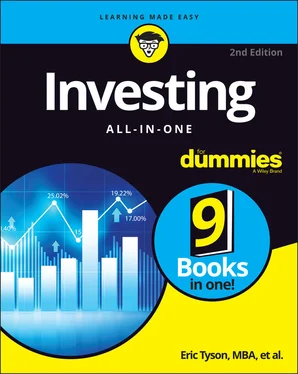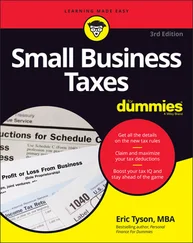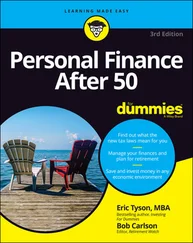Eric Tyson - Investing All-in-One For Dummies
Здесь есть возможность читать онлайн «Eric Tyson - Investing All-in-One For Dummies» — ознакомительный отрывок электронной книги совершенно бесплатно, а после прочтения отрывка купить полную версию. В некоторых случаях можно слушать аудио, скачать через торрент в формате fb2 и присутствует краткое содержание. Жанр: unrecognised, на английском языке. Описание произведения, (предисловие) а так же отзывы посетителей доступны на портале библиотеки ЛибКат.
- Название:Investing All-in-One For Dummies
- Автор:
- Жанр:
- Год:неизвестен
- ISBN:нет данных
- Рейтинг книги:3 / 5. Голосов: 1
-
Избранное:Добавить в избранное
- Отзывы:
-
Ваша оценка:
- 60
- 1
- 2
- 3
- 4
- 5
Investing All-in-One For Dummies: краткое содержание, описание и аннотация
Предлагаем к чтению аннотацию, описание, краткое содержание или предисловие (зависит от того, что написал сам автор книги «Investing All-in-One For Dummies»). Если вы не нашли необходимую информацию о книге — напишите в комментариях, мы постараемся отыскать её.
Investing All-in-One For Dummies
.
Dummies
Investing All-in-One For Dummies
Investing All-in-One For Dummies
Investing All-in-One For Dummies — читать онлайн ознакомительный отрывок
Ниже представлен текст книги, разбитый по страницам. Система сохранения места последней прочитанной страницы, позволяет с удобством читать онлайн бесплатно книгу «Investing All-in-One For Dummies», без необходимости каждый раз заново искать на чём Вы остановились. Поставьте закладку, и сможете в любой момент перейти на страницу, на которой закончили чтение.
Интервал:
Закладка:
Assume that you qualify for financial aid. Financial aid consultants agree that you should assume you’re eligible. Don’t rule yourself out because of income or academics. And don’t rule out a college because you think it’s too expensive. The higher the cost, the more aid you may receive.
Use colleges’ “net price calculator” to estimate your expected costs. No matter where you are in the planning process, there is a simple method you can use now to get a general idea as to what price you may pay at a given college or university (and therefore how much financial aid or discount you will receive from those institutions). Colleges are required to have a net price calculator (NPC) on their websites. The pricing among private colleges can differ by tens of thousands of dollars among schools driven by factors like how much equity a family has in their home.
Fill out the FAFSA form online. The Free Application for Federal Student Aid — also known as the FAFSA form — is the starting point in applying for financial aid. You can complete the FAFSA form online ( studentaid.gov ).
Don’t wait around to be accepted to a college to apply for aid. The coffers may be empty by spring, so get application forms completed as soon as possible. You’ll need the latest version of the federal FAFSA form. You may also need to complete the College Board’s CSS Profile application ( cssprofile.collegeboard.org ), state aid forms, and/or forms provided by the colleges. The FAFSA form and Profile become available for the next academic year on October 1 of the current year (meaning the soonest you can apply for financial aid for your first year of college is October 1 of senior year of high school).Parents, keep in mind that the questions presume that the student is applying for aid (even though parents fill out the form!). Be aware that questions like name, address, social security number, date of birth, and so on in the beginning part of the form refer to the student. Parent information is collected later in the form. Entering parent information in a student section is a common mistake, and it can cause problems for your financial aid application.
 As Chapter 1in Book 2 discusses, there are increasing numbers of faster and cheaper alternatives to traditional four-year colleges which lead to interesting and rewarding jobs and careers. For more information, pick up a copy of Paying For College For Dummies by Eric Tyson, MBA (Wiley).
As Chapter 1in Book 2 discusses, there are increasing numbers of faster and cheaper alternatives to traditional four-year colleges which lead to interesting and rewarding jobs and careers. For more information, pick up a copy of Paying For College For Dummies by Eric Tyson, MBA (Wiley).
Considering educational savings account options
You’ll hear about various accounts you can use to invest money for your kid’s future college costs. Tread carefully with these, especially because they can affect future financial aid.
The most popular of these accounts are qualified state tuition plans, also known as Section 529 plans. These plans offer a tax-advantaged way to save and invest more than $100,000 per child toward college costs. (Some states allow upward of $300,000 per student.) After you contribute to one of these state-based accounts, the invested funds grow without taxation. Withdrawals are also tax-free provided the funds are used to pay for qualifying higher-education costs (which include college, graduate school, and certain additional expenses of special-needs students) as well as up to $10,000 per year toward K-12 school expenses. (The schools need not be in the same state as the state administering the Section 529 plan.)
Section 529 plan balances can harm your child’s financial aid chances. Thus, such accounts make the most sense for affluent families who are sure they won’t qualify for any type of financial aid. If you do opt for a 529 plan and intend to apply for financial aid, you should be the owner of the accounts (not your child) to maximize qualifying for financial aid.
Investing money earmarked for college
Diversified mutual funds and exchange-traded funds — which invest in stocks in the United States and internationally, as well as bonds — are ideal vehicles to use when you invest money earmarked for college. Be sure to choose funds that fit your tax situation if you invest your funds in nonretirement accounts.
When your child is young (preschool age), consider investing up to 80 percent of your investment money in stocks (diversified worldwide) with the remainder in bonds. Doing so can maximize the money’s growth potential without taking extraordinary risk. As your child makes their way through the later years of elementary school, you need to begin to make the mix more conservative. Scale back the stock percentage to 50 or 60 percent. Finally, in the years just before the child enters college, reduce the stock portion to no more than 20 percent or so.
Some 529s offer target-date-type funds that reduce the stock exposure as target college dates approach so you don’t have to make the adjustments yourself.
Securing Proper Insurance
Although many people lack particular types of insurance, others possess unnecessary policies. Many people also keep very low deductibles. Remember to insure against potential losses that would be financially catastrophic for you; don’t waste your money to protect against smaller losses.
 You may be at risk of making a catastrophic investing mistake by not protecting your assets properly. Decisions regarding what amount of insurance you need to carry are, to some extent, a matter of your desire and ability to accept financial risk. But some risks aren’t worth taking. Don’t overestimate your ability to predict what accidents and other bad luck may befall you.
You may be at risk of making a catastrophic investing mistake by not protecting your assets properly. Decisions regarding what amount of insurance you need to carry are, to some extent, a matter of your desire and ability to accept financial risk. But some risks aren’t worth taking. Don’t overestimate your ability to predict what accidents and other bad luck may befall you.
Consider the following types of insurance to protect yourself, your loved ones, and your assets:
Major medical health insurance: You need a policy that pays for all types of major illnesses and major medical expenditures. If your financial situation allows, consider taking a health plan with a high deductible, which can minimize your premiums. Also consider channeling extra money into a health savings account (HSA), which provides tremendous tax breaks. As with a retirement account, contributions provide an up-front tax break, and money can grow over the years in an HSA without taxation. You can also tap HSA funds without penalty or taxation for a wide range of current health expenses.
Adequate liability insurance on your home and car to guard your assets against lawsuits: You should have at least enough liability insurance to protect your net worth (assets minus your liabilities/debts) or, ideally, twice your net worth. If you run your own business, get insurance for your business assets if they’re substantial. Also consider professional liability insurance to protect against a lawsuit. You may also want to consider incorporating your business.
Long-term disability insurance: Even if you don’t have dependents, odds are that you’re dependent on your employment income. What would you (and your family) do to replace your income if a major disability prevented you from working? Most large employers offer group plans that have good benefits and are much less expensive than coverage you’d buy on your own. Also check with your professional association for a competitive group plan.
Life insurance, if others are dependent on your income: If you’re single or your loved ones can live without your income, skip life insurance. If you need coverage, buy term insurance that, like your auto and home insurance, is pure insurance protection. The amount of term insurance you need to buy largely depends on how much of your income you want to replace.
Читать дальшеИнтервал:
Закладка:
Похожие книги на «Investing All-in-One For Dummies»
Представляем Вашему вниманию похожие книги на «Investing All-in-One For Dummies» списком для выбора. Мы отобрали схожую по названию и смыслу литературу в надежде предоставить читателям больше вариантов отыскать новые, интересные, ещё непрочитанные произведения.
Обсуждение, отзывы о книге «Investing All-in-One For Dummies» и просто собственные мнения читателей. Оставьте ваши комментарии, напишите, что Вы думаете о произведении, его смысле или главных героях. Укажите что конкретно понравилось, а что нет, и почему Вы так считаете.












